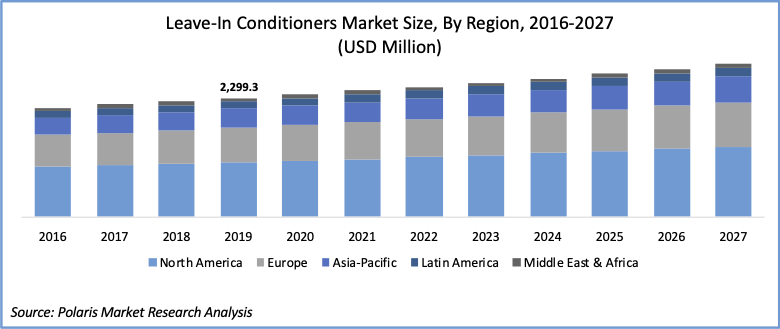
Leave-in Conditioner Market Share, Size, Trends, Industry Analysis Report, By Form (Semi-Liquid, and Liquid); By Packaging Format (Pouch, Sprays, Containers/Bottles, and Tube); By Distribution Channel (Brick & Mortar Stores, Online Retail Channels, and Institutional Sales); By End Use (DIY, and Professionals); By Regions; Segment Forecast, 2020 – 2027
- Published Date:Oct-2020
- Pages: 97
- Format: PDF
- Report ID: PM1725
- Base Year: 2019
- Historical Data: 2016 - 2018
Report Outlook
The global leave-in conditioner market was valued at USD 2,299.32 million in 2019 and is expected to grow at a CAGR of 3.2% during the forecast period. The factors such as perception towards healthy scalp of being shining and lustrous, product innovations, innovative target segmentation, and research and development in the conditioner segment are responsible for its market growth.
The rising popularity of leave-in conditioner treatments to amplify the hair elasticity and strength of hair, the demand of these conditioners is soaring. Leave-in conditioner have high adoptions rate among young women within an age group of 20 and 30 years. Moreover, the fast-paced work environment with very less self caring time to look after ourselves, the product finds itself in demanding position for hair management and its hygiene, which ultimately creates unique opportunities for the popular brands to reap benefits.
 Know more about this report: request for sample pages
Know more about this report: request for sample pages
Industry Dynamics
Growth Drivers
The popularity of online retail channel has opened up new avenues of growth for the hair care industry and anticipate the sales of leave-in conditioners across the globe. Consumers are now in a position to browse various products over internet, ask for claims types and hair types leave-in conditioners, and get the products delivered to their residents or salons. Innovation in technology, especially in terms of app and website development, has made it possible for the consumers to view different products before finalizing the leave-in conditioner. The popularity of online stores offering leave-in conditioner is likely to provide an impetus to the growth of the overall market. The easier availability of leave-in conditioner in different price ranges is paving the way for rising adoption of leave-in conditioner among various classes of consumers.
 Know more about this report: request for sample pages
Know more about this report: request for sample pages
Market players involved in the global market are focused on adopting innovative technologies, such as digital marketing and reviews for brand endorsement. Players are concentrating on marketing strategies to stay ahead in intense competition within the industry. The market is not only targeting higher income groups but also availing salon services for the middle-class population in order to build brand image across all kinds of consumers. Radical advancement in salon consultation provided by professionals, capital investment on signature and exclusive cuisine is expected to draw a huge number of local visitors. In addition, foreign companies are expected to expand the salon center chain across different locations. Thereby, the leave-in conditioner market foresees tremendous growth owing to innovative marketing and diversity in salon services.
Challenges
However, the global market is flooded with the counterfeit adulterated products, and the use of chemical ingredients limiting the adoption of leave in conditioner. Various chemical ingredients are used in the hair conditioners, which hinders the market growth. Globally, there are no stringent rules available for product safety, therefore manufactures are not concerned about chemicals, which have been used in the concerned product. Nowadays, consumers are more health conscious and aware about the ingredients used in personal care products. These health concerns could urge them to avoid buying such chemical-based products.
Leave-in Conditioner Market Report Scope
The market is primarily segmented on the basis of Form, By Packaging Format, By Distribution Channel, By End-Use, and geographic region.
|
By Form |
By Packaging Format |
By Distribution Channel |
By End Use |
By Region |
|
|
|
|
|
Know more about this report: request for sample pages
Insight by Packaging Format
Based upon the packaging format, the global market is categorized into Pouch, Sprays, Containers/Bottles, and Tube. In 2019, the container/bottles segment accounted for the largest share among all. This high share is due to the more quantity it can store and supply, in a scenario of high consumer demand. The segment is also expected maintain is dominance over the study period. The pouch segment registered the highest growth rate among all over the study period. This high growth is attributed to the fact it increases the affordability among the lower strata of population in middle and low income countries. Moreover, pouches are easier to transport and carry, which further boost its adoption, particularly among women.
Insight by Distribution Channels
Based on distribution channel, the global market is bifurcated into Brick & Mortar Stores, Online Retail Channels, and Institutional Sales. In 2019, the institutional sales segment recorded highest market share among all. The factors responsible for this include the legacy of companies in distributing their products through its dedicated channels, and the expertise and manpower present in in the supply chain network of such system.
Geographic Overview
Geographically, North America is the largest contributor in the leave-in conditioner market, followed by Europe and Asia Pacific. In 2019, North America accounted for more than 40.5% of the global market. The US was the largest contributor to the market in terms of revenue.
Increasing demand for conditioner in the emerging economies is expected to drive the global market over the forecast period. This is attributed to the burgeoning middle class people with rising income and lifestyle standards. Middle and low income countries represent major potential for leave-in conditioners. Growing consumer awareness and willingness have spending on self caring products such as shampoos, and conditioners is resulted in varying consumption patterns. Emerging economies such as, India and China, represent substantial represent high potential for such products, which is likely to yield major revenue opportunities.
When income levels rise, consumers can spend more money on industry products. Per-capita disposable income is expected to increase, representing a potential opportunity for the industry. The increase in disposable income has generated a new category of consumers - the middle-class - that drives sales. The industry’s performance depends on active consumer spending. With more disposable income, consumers are more likely to purchase personal-care products and services, such as those offered in the industry. China’s beauty and personal care industry has undergone a significant transformation over the past decade, owing to its rapid economic progress. A stable and continuous economic growth has significantly increased per capita disposable income, with people nearly doubling the amount of disposable income.
Competitive Insight
The market is highly competitive with the presence of well-established players. Major key strategy of these players is towards launch of new product, collaboration with respect to manufacturing & distribution, expansion and acquisition. Key players in the market include Unilever Plc., Sun bum, L'Oréal S.A., Bumble & Bumble, Procter & Gamble Co., Kao Corporation, Estee Lauder Companies Inc., Suave, Sephora Inc. (LVMH), Sally Beauty Holding, The Body Shop, Shea Moisture, and Paul Mitchell. For instance, Sephora Inc. in 2017, increased its online presence in the Middle East countries, and Mexico. Le Bon Marche has established new online 24 hours’ experiential digital platform.
